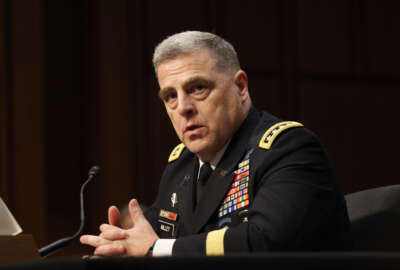
Mattis begins military beef up with memo
Defense Secretary James Mattis laid out plans for the next six years in a Feb. 1 memo.
The Defense Department is making a big push for capacity building and to reform its business practices over the next six years.
In a memo released Feb. 1, Defense Secretary James Mattis said DoD will focus its 2018 budget on “growing the force structure to the maximum responsible rate.”
Mattis explained the 2018 budget will address pressing programmatic shortfalls and rebuild readiness. That includes building programs for advanced capabilities as well as buying critical munitions and funding facilities sustainment at a higher level.
The memo stated DoD will deliver its request to the Office of Management and Budget by May 1.
How much money Mattis wants to pour into building those capabilities and capacities is still unknown. President Donald Trump said he wanted to build the Army’s capacity by at least 60,000 active duty troops and to build the Navy to 350 ships.
But Mattis is looking to build the military past 2018. Mattis’ memo calls for a defense strategy from 2019 to 2023 with a new force sizing construct to inform growth and improve the way DoD does business.
“We owe it to every U.S. citizen to build a military that is as effective and efficient as possible,” the memo stated. The 2019 to 2023 defense program will “contain an ambitious reform agenda, which will include horizontal integration across DoD components to improve efficiency and take advantage of economies of scale. “
The memo also mentioned DoD is putting together a 2017 amendment to President Barack Obama’s 2017 budget request. That request would focus more on urgent warfighting needs. Obama requested $583 billion for 2017.
Congress authorized $619 billion for DoD in its 2017 defense authorization act. Congress still hasn’t passed a defense appropriations bill to actually fund DoD, so it is still functioning at 2016 levels of $573 billion.
While Congress bumped up the amount authorized to spend in the 2017 defense authorization bill, it still left some items on the table that it wanted funded.
Budget caps from 2015 prevented the bill from authorizing more. House Armed Services Chairman Mac Thornberry (R-Texas) suggested a supplemental budget outside of the caps to pay for even more defense programs.
Getting bigger
There are still some issues in beefing up the military. DoD can’t just put money into adding more troops and ships. Other areas need to grow with the force or prioritized funding.
Both the Army and Navy service chiefs said their readiness needs triage before force and fleet size can be addressed.
“Readiness will remain the number one priority,” Army Chief of Staff Gen. Mark Milley said last month. “If we’ve got some significant increase in money we will continue to prioritize readiness. Having said that, we have got to get after modernization, so there’s going to be a balance between the two.”
Milley said modernization priorities were in air defense, aviation and electronic warfare.
Milley warned that putting that money into force structure without addressing readiness could be detrimental to the service.
Latest Defense News
“If, for example, we did have additional people, it’s important that we get the money with the people because if we just get additional people or additional end strength, but we don’t have the money then that leads you down the road to a hollow force and we don’t want that,” Milley said. “If we do increase the people, the first thing we need to do is improve the manning levels in the existing organizations because our formations are under strength.”
The Navy said the same thing.
Vice Chief of Naval Operations Adm. William Moran said the Navy wants its first extra dollar to go toward readiness.
“This is a long war we’ve been in, we’ve got emerging and reemerging threats that have all raised the stakes on making this long game even longer and we are not going to stay healthy if we don’t pay attention to our maintenance accounts,” Moran said during a Jan. 11 Surface Navy Symposium event in Arlington, Virginia. The “274 [ships], that 308 or that 350 is not going to be the same number at readiness funding levels that we have today.”
Trump and DoD will have to add a lot more money than it costs just to increase the force. That will require a sequestration work around and help from Democrats.
Copyright © 2025 Federal News Network. All rights reserved. This website is not intended for users located within the European Economic Area.
Scott Maucione is a defense reporter for Federal News Network and reports on human capital, workforce and the Defense Department at-large.
Follow @smaucioneWFED




